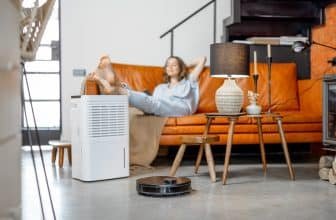How Air Purifiers Effectively Filter Smoke and Odors in Living Spaces
Smoke and unpleasant odors can be a nuisance in living spaces. Whether it’s from cooking, smoking, or other activities, the smell can linger and affect the indoor air quality. This is where air purifiers come in handy. Air purifiers are designed to filter out smoke and odors, making the air cleaner and fresher to breathe.

Understanding how air purifiers work and the different types of filters available is essential to choosing the right air purifier for your needs. Assessing air purifier performance is also important to ensure that the air purifier is effective in filtering out smoke and odors. Room size and air purifier capacity are also factors to consider when choosing an air purifier.
Overall, air purifiers are an effective solution for filtering smoke and unpleasant odors in living spaces. With the right air purifier, indoor air quality can be improved, leading to a healthier and more comfortable living environment.
Odor and Smoke Be Gone: The Role of Air Purifiers in Maintaining Fresh Living Spaces
- Air purifiers are designed to filter out smoke and unpleasant odors, making the air cleaner and fresher to breathe.
- Understanding how air purifiers work and assessing their performance is important when choosing the right air purifier for your needs.
- With the right air purifier, indoor air quality can be improved, leading to a healthier and more comfortable living environment.
Understanding Air Purifiers and Filters
Air purifiers are devices that help improve indoor air quality by removing pollutants, contaminants, and other harmful particles from the air. They are particularly useful in reducing the levels of smoke and unpleasant odors caused by cooking or other activities that produce fumes.
Types of Air Purifiers
There are several types of air purifiers available in the market, each with its own unique features and benefits. Some of the most common types include:
-
HEPA Filters: HEPA (High-Efficiency Particulate Air) filters are designed to remove tiny particles such as dust, pollen, and pet dander from the air. They are highly effective in capturing particles as small as 0.3 microns in size.
-
Activated Carbon Filters: Activated carbon filters work by adsorbing odors, chemicals, and gases from the air. They are particularly useful in reducing the levels of smoke and unpleasant odors caused by cooking or other activities.
-
UV-C Light Purifiers: UV-C light purifiers use ultraviolet light to kill bacteria, viruses, and other microorganisms in the air. They are highly effective in reducing the spread of airborne diseases.
How HEPA Filters Work
HEPA filters work by trapping tiny particles in a dense web of fibers. As air passes through the filter, the fibers capture the particles, preventing them from circulating back into the room. HEPA filters are highly effective in removing particles such as dust, pollen, and pet dander from the air.
The Role of Activated Carbon Filters
Activated carbon filters work by adsorbing odors, chemicals, and gases from the air. They contain a layer of activated carbon, which is made up of tiny pores that trap and hold onto pollutants. Activated carbon filters are particularly useful in reducing the levels of smoke and unpleasant odors caused by cooking or other activities.
In summary, air purifiers are an effective way to improve indoor air quality and reduce the levels of smoke and unpleasant odors caused by cooking or other activities. HEPA filters and activated carbon filters are two of the most common types of air filters used in air purifiers, each with its own unique features and benefits.
Assessing Air Purifier Performance
Air purifiers are efficient appliances that can help reduce smoke and unpleasant odors caused by cooking or other activities in living spaces. However, not all air purifiers are created equal. To assess the performance of an air purifier, several factors should be considered.
CADR Explained
CADR, or Clean Air Delivery Rate, is a measure of an air purifier’s effectiveness in removing smoke, dust, and pollen from the air. The higher the CADR rating, the more efficient the air purifier is at removing these particles. According to U.S. News, a CADR rating of at least 300 is recommended for smoke removal in rooms up to 300 square feet.
Importance of Fan Speed
Fan speed is another important factor to consider when assessing air purifier performance. The higher the fan speed, the more air the purifier can filter in a shorter amount of time. However, higher fan speeds can also result in louder noise levels. It is recommended to choose an air purifier with multiple fan speed settings, so the user can adjust the fan speed according to their needs.
Filter Replacement and Maintenance
Filter replacement and maintenance are also essential considerations when assessing air purifier performance. The filter is the component that captures and removes pollutants from the air. Over time, the filter will become clogged with pollutants and will need to be replaced. The frequency of filter replacement depends on the type of filter and the level of pollutants in the air. It is recommended to follow the manufacturer’s instructions for filter replacement and maintenance to ensure the air purifier continues to perform efficiently.
In summary, when assessing air purifier performance, CADR rating, fan speed, filter replacement, and maintenance are important factors to consider. By choosing an air purifier with a high CADR rating, adjustable fan speeds, and following the manufacturer’s instructions for filter replacement and maintenance, users can effectively reduce smoke and unpleasant odors in their living spaces.
Air Purifiers for Specific Needs
Air purifiers are designed to filter out different types of pollutants from the air, including smoke particles, unpleasant odors, and pet dander. Depending on the specific needs of your living space, there are different types of air purifiers that can help improve your indoor air quality. In this section, we will discuss some of the best air purifiers for smoke, combating cooking odors, and managing pet dander and allergens.
Best Air Purifiers for Smoke
Smoke particles can be harmful to your health, and they can also leave behind unpleasant odors that can be difficult to get rid of. Air purifiers that are designed to filter out smoke particles can help improve the air quality in your living space and reduce the risk of health problems. Some of the best air purifiers for smoke include:
-
Rabbit Air A3 Ultra Quiet Air Purifier: This air purifier is designed to filter out smoke particles and other pollutants from the air. It features a HEPA filter that can capture particles as small as 0.3 microns, as well as an activated carbon filter that can help eliminate odors.
-
Blueair Blue Pure 211+: This air purifier is another great option for filtering out smoke particles. It features a three-part filtration system that includes a pre-filter, a particle filter, and an activated carbon filter. It is also Energy Star certified, which means it is energy-efficient and can help reduce your electricity bills.
Combating Cooking Odors
Cooking odors can be difficult to get rid of, especially if you cook frequently or use strong spices and ingredients. Air purifiers that are designed to combat cooking odors can help eliminate these unpleasant smells and improve the air quality in your living space. Some of the best air purifiers for combating cooking odors include:
-
Dyson Pure Hot + Cool Cryptomic: This air purifier is designed to capture cooking odors and other pollutants from the air. It features a HEPA filter that can capture particles as small as 0.3 microns, as well as a carbon filter that can help eliminate odors. It also has a Cryptomic filter that can destroy formaldehyde molecules, which are commonly found in cooking fumes.
-
Coway Airmega 400: This air purifier is another great option for combating cooking odors. It features a four-stage filtration system that includes a pre-filter, a HEPA filter, an activated carbon filter, and an ionizer. It also has a smart mode that can adjust the fan speed based on the air quality in your living space.
Managing Pet Dander and Allergens
Pet dander and allergens can be a major problem for people with allergies or respiratory issues. Air purifiers that are designed to manage pet dander and allergens can help reduce the amount of these particles in the air and improve your indoor air quality. Some of the best air purifiers for managing pet dander and allergens include:
-
Winix HR900: This air purifier is designed to capture pet dander and other allergens from the air. It features a five-stage filtration system that includes a pre-filter, a HEPA filter, an activated carbon filter, a pet filter, and a PlasmaWave filter. It also has a smart sensor that can detect the air quality in your living space and adjust the fan speed accordingly.
-
Honeywell HPA300: This air purifier is another great option for managing pet dander and allergens. It features a three-stage filtration system that includes a pre-filter, a HEPA filter, and an activated carbon filter. It is also Energy Star certified, which means it is energy-efficient and can help reduce your electricity bills.
Room Size and Air Purifier Capacity

Air purifiers come in different sizes and capacities. When choosing an air purifier, it is important to consider the size of the room where it will be used. A purifier that is too small for the room will not be effective in cleaning the air, while one that is too large will waste energy and money.
Calculating Coverage Area
To determine the appropriate air purifier capacity, it is necessary to calculate the coverage area of the room. This can be done by measuring the length and width of the room and multiplying the two numbers to get the square footage. For example, a room that is 12 feet by 15 feet has a square footage of 180 square feet.
Air Purifiers and Square Footage
Air purifiers are designed to clean the air in a specific square footage range. The coverage area of an air purifier is usually indicated on the packaging or in the product specifications. It is important to choose an air purifier that is designed for the size of the room where it will be used.
For example, a small air purifier with a coverage area of 100 square feet would be appropriate for a small bedroom or office, while a larger air purifier with a coverage area of 500 square feet would be more suitable for a living room or large bedroom.
When choosing an air purifier, it is also important to consider the air quality of the room. If the room is heavily polluted, such as from cigarette smoke or cooking odors, a higher capacity air purifier may be necessary to effectively clean the air.
In summary, when choosing an air purifier, it is important to consider the size of the room and the coverage area of the air purifier. By choosing the right air purifier for the room, one can effectively filter smoke and unpleasant odors caused by cooking or other activities.
Features and Functionality

Air purifiers are designed to filter out smoke and unpleasant odors from living spaces. When selecting an air purifier, it is important to consider the features and functionality that will best suit your needs.
Smart Air Purifiers and Voice Control
Some air purifiers come with smart features that allow you to control them using your smartphone or voice commands. These devices can be connected to your home’s Wi-Fi network, allowing you to adjust the settings from anywhere in the house. With voice control, you can simply ask your virtual assistant to turn on the air purifier, adjust the fan speed, or activate sleep mode.
Additional Features for Convenience
Air purifiers can come with a variety of additional features that make them more convenient to use. For example, some models have an auto mode that adjusts the fan speed based on the air quality in the room. Others have multiple fan speeds that allow you to choose the level of filtration you need. Some air purifiers also have a sleep mode that reduces noise levels and turns off the LCD screen to help you get a good night’s rest.
Other additional features that may be available include an LCD screen that displays the current air quality level, a filter replacement indicator that lets you know when it’s time to change the filter, and a timer that allows you to set the air purifier to run for a certain amount of time.
Overall, the features and functionality of an air purifier will depend on the specific model you choose. It is important to consider your needs and preferences when selecting an air purifier to ensure that it will effectively filter smoke and unpleasant odors from your living space.
Health Benefits and Indoor Air Quality
Air purifiers can be an effective solution for filtering smoke and unpleasant odors caused by cooking or other activities. Not only do they help to keep the air in your living space smelling fresh, but they can also improve your health by reducing exposure to harmful pollutants.
Reducing Health Risks from Smoke and VOCs
Wildfire smoke and cigarette smoke are two common sources of indoor air pollution that can have serious health consequences. According to the EPA, exposure to smoke can cause respiratory irritation, reduced lung function, and even premature death in some cases. Air purifiers can help to remove smoke particles and other pollutants from the air, reducing the risk of these negative health effects.
Volatile organic compounds (VOCs) are another common indoor air pollutant that can have negative health consequences. VOCs are emitted by a wide range of household products, including cleaning supplies, paints, and furniture. Exposure to VOCs can cause headaches, dizziness, and other symptoms, and may even increase the risk of cancer in some cases. Air purifiers can help to remove VOCs from the air, reducing the risk of these negative health effects.
Improving Air Quality for Asthma and Allergy Sufferers
Air purifiers can also be particularly helpful for individuals with asthma or allergies. According to the American Lung Association, indoor air pollution can be a trigger for asthma attacks, and can also worsen allergy symptoms. Air purifiers can help to remove common allergens such as dust, pet dander, and pollen from the air, reducing the risk of these negative health effects.
Formaldehyde and particulate matter are two additional indoor air pollutants that can have negative health consequences. Formaldehyde is a common VOC that is emitted by building materials and furniture, and exposure to high levels can cause respiratory irritation and other symptoms. Particulate matter, which includes tiny particles such as dust and smoke, can also cause respiratory irritation and other health problems. Air purifiers can help to remove both formaldehyde and particulate matter from the air, improving indoor air quality and reducing the risk of negative health effects.
Design and Aesthetics
Air purifiers are an essential appliance in any living space, especially for those who are sensitive to smoke and unpleasant odors. However, many people are hesitant to invest in an air purifier because they believe it will clash with their interior design. Fortunately, modern air purifiers come in sleek designs that can easily blend in with any furniture.
Air Purifier Placement and Room Integration
When it comes to air purifier placement, it’s important to consider the layout of the room. Ideally, the air purifier should be placed in a central location where it can effectively circulate clean air throughout the room. It’s also important to consider the size of the room and choose an air purifier that can handle the square footage.
In addition to placement, air purifiers can be integrated into the room’s design in various ways. For example, some air purifiers come with customizable panels that can be matched to the color of the walls or furniture. Others come in unique shapes and sizes that can serve as a statement piece in the room.
Stylish and Compact Air Purifiers
For those who prioritize style, there are plenty of air purifiers on the market that are designed to be both functional and fashionable. Many modern air purifiers come in sleek, compact designs that are easy to move around and can fit into tight spaces.
Some air purifiers even come with additional features such as ambient lighting or Bluetooth speakers, making them a versatile addition to any living space. With so many options available, it’s easy to find an air purifier that not only matches your design preferences but also fits seamlessly into your lifestyle.
In summary, air purifiers are an essential appliance for those who are sensitive to smoke and unpleasant odors. Fortunately, modern air purifiers come in sleek designs that can easily blend in with any furniture. With proper placement and integration, air purifiers can even enhance the overall aesthetic of a room.
Environmental and Cost Considerations

When considering the purchase of an air purifier, it is important to take into account both the environmental impact and the long-term costs associated with owning and operating the device. Here are some key factors to consider:
Energy Efficiency and Certification
One important consideration when purchasing an air purifier is its energy efficiency. Look for models that have been certified by Energy Star, a program that identifies products that meet strict energy efficiency guidelines set by the U.S. Environmental Protection Agency. Energy Star-certified air purifiers use 40% less energy than standard models, which can save you money on your energy bills over time.
Long-Term Costs and Value
While air purifiers can be a significant investment up front, they can also save you money in the long run by improving your indoor air quality and preventing the need for costly repairs or renovations due to smoke or other pollutants. When shopping for an air purifier, consider the long-term costs and value of the device, including factors such as filter replacement costs and the lifespan of the device.
Budget Option
For those on a tight budget, there are also cost-effective air purifiers available that can effectively filter smoke and unpleasant odors. Look for models with HEPA filters, which are designed to capture small particles such as smoke and dust. While these models may not have all the features of more expensive models, they can still provide effective air purification at a lower cost.
Frequently Asked Questions
What type of air purifier is most effective for eliminating cooking odors?
Air purifiers with activated carbon filters are the most effective for eliminating cooking odors. These filters work by adsorbing the odors produced during cooking, thus removing them from the air. It is recommended to choose an air purifier with a high-quality activated carbon filter for maximum effectiveness.
Can air purifiers with HEPA filters also remove smoke particles?
Yes, air purifiers with HEPA filters can remove smoke particles from the air. HEPA filters are designed to capture small particles, including smoke particles, and are highly effective at doing so. However, it is important to note that HEPA filters are not designed to remove odors, so they may not be as effective at eliminating the smell of smoke.
How do carbon filters in air purifiers tackle cigarette smoke and odors?
Carbon filters in air purifiers tackle cigarette smoke and odors by adsorbing the chemicals and gases produced by cigarette smoke. The activated carbon in the filter acts like a sponge, trapping the smoke particles and removing them from the air. It is important to note that carbon filters can become saturated over time and will need to be replaced for continued effectiveness.
Are there specific air purifiers recommended for handling secondhand smoke?
Air purifiers with HEPA and activated carbon filters are recommended for handling secondhand smoke. It is important to choose an air purifier with a high-quality activated carbon filter to effectively remove the odors associated with secondhand smoke.
What features should I look for in an air purifier to address kitchen smells?
When choosing an air purifier to address kitchen smells, it is important to look for an air purifier with a high-quality activated carbon filter. Additionally, it may be beneficial to choose an air purifier with a pre-filter to capture larger particles, such as cooking grease and oil, before they reach the activated carbon filter.
How can I ensure my air purifier is efficient in removing both smoke and odors?
To ensure your air purifier is efficient in removing both smoke and odors, it is important to choose an air purifier with both a HEPA filter and an activated carbon filter. Additionally, it is important to regularly replace the filters in your air purifier to maintain its effectiveness.






